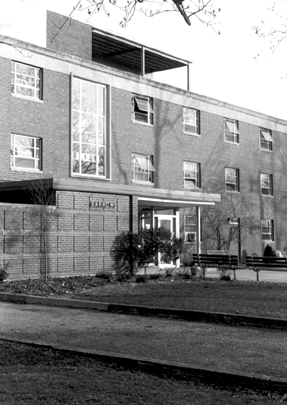

This fall when students return for classes almost half of Barrows Hall will be gone. In its place will be the skeleton of the new Science Center.
The change, which will permanently eliminate 52 beds, raises many questions. Should the rest of Barrows remain a first-year hall? Should it be turned into a program house? Will the rooms, with the construction of the Science Center right next door, be too noisy to live in? Should another dorm become the first-year hall? Where will the 50 displaced students live?
Deb McNish, interim dean of student life and services, said that while she and her staff don't have answers yet, they are working hard to come up with a plan that addresses the most student needs and concerns.

No matter what happens, Student Life and Services staff recognize the change is a big deal to students. "This little change is going to be extremely impactful," she said.
McNish said she and her staff have begun talking to students about what they would like to see happen next year.
"We met with some students over Winter Term and talked about the possibilities," McNish said. "But the opinions were all over the place." A chat room on the Residential Life web site has elicited a whole range of ideas as well, she said. McNish said she is keeping the options open and trying to listen to student concerns.
Under consideration are Dascomb, Burton, Noah and Barrows. Each have advantages and disadvantages that are being weighed.
Residential Life views Dascomb's relatively small number of singles as an advantage. However, with an excessive 160 beds, their allocation to first-years only would remove too many "traditional" rooms from south campus. Many conservatory students who don't choose to live in program houses have difficulty finding other housing on south campus, and losing Dascomb to first-years would confound the situation.
Burton has advantages in that it has ample common space, but it has 20 singles that would have to be dealt with.
Noah is smaller than Burton which is advantageous, but it also has 20 singles. Barrows has remained an option, but it is losing the Area Coordinator apartment to the demolition and Residential Life sees professional staff in residence as a real advantage.
These ideas are just that, though. Residential Life is striving to remain flexible through the brain storming phase.
One fact that is not flexible, however, is that the College needs the revenue from the 80 rooms it will lose. McNish said all staff and faculty apartments in dorms will be eliminated to make space for more student dorms. In addition, the option of moving computer coordinators and admissions coordinators into singles is being considered. "We are going to absorb every empty space," she said, adding that if current dorms don't provide enough rooms the College might use off-campus property as well.
McNish encouraged students to visit the Residential Life web site to share their opinion on what should happen to Barrows and the first-year dorm concept. She also wants students to participate in forums that will be held throughout the semester.
The first forum will be held next week.
In addition to working with students, McNish said a proposal to address the issue will go through both the Housing and Dining Committee and the Student Life Committee.
End of Barrows?: Part of Barrows Hall will be demolished over the summer to make room for the new Science Center. With the upcoming elimination of 52 student beds, Student Life staff members are trying to devise a plan to deal with the changes. (photo by Susanna Henighan)
Copyright © 1999, The Oberlin Review.
Volume 127, Number 13, February 12, 1999
Contact us with your comments and suggestions.